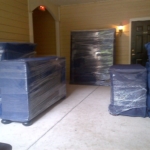One of the most important moving tasks is selecting and gathering your moving supplies. And in many cases, you’ll be faced with the question of “paper or plastic?” When it comes to boxes as well as when it comes to box stuffing to protect your belongings. The first one might be easy to answer, but we often find that families don’t know what to choose when it comes to packing paper vs. air bubble packing. And the truth is, there isn’t a right or wrong answer. Both have their advantages, and both have their disadvantages. That’s where this month’s blog post comes in. Below, we’ll dive deep into this paper vs. plastic debate and provide you with the insight you need to ensure you use the proper box stuffer at the appropriate time. We’ll explain what each option is for those of you who don’t know as well as list their advantages and when to use each one.
And as always, if you have any questions about this blog post, your upcoming move or moving in general, we encourage you to reach out to us on Facebook or by calling or emailing us.
Happy reading!
Packing Paper
What is it?
Simply put, packing paper is, well, paper. But not just ordinary paper you’d find in your printer or notebook at home. Packing paper is unique because it’s much softer and thicker than regular paper. When compared to ordinary paper, it’ll also “ball up” or crumple rather than fold and crease. This is one of the main reasons it can be used for packing whereas ordinary paper cannot. Packing paper is often tan or beige and typically comes in much larger sheets than a standard 8.5″x11″ piece of paper.
Advantages
Despite being a very simple material, there’s a reason that packing paper has remained as one of the most popular and common box stuffers. This is because it offers movers many different advantages that simply can’t be rivalled by anything else.
- Soft: Unlike ordinary paper, packing paper is exceptionally soft and gentle. This makes it perfect for using on items you might be worried about scratching. Things like fine china, electronics and other delicate items are all excellent examples of when to use packing paper.
- Can Be Tightly-Wrapped: Because packing paper is extremely thin, it makes it possible to wrap it tightly around any item you wish to protect. It easily follows the contours of any item with little effort needed on your end and can be secured in place with a bit of tape.
- Takes Up Minimal Space: Thanks to its minimal thickness and its ability to be tightly-wrapped, packing paper also takes up much less space in boxes than other packing material. This should go a long way in minimizing the number of boxes you need and possibly save you some money along the way.
- Durable: As thin as we said packing paper is, it’s also extremely durable. One single sheet of packing paper is much more durable than ordinary paper or even newspaper (an alternative many people tend to choose), and when you combine multiple sheets of packing paper on top of one another, you can very effectively protect fragile items— all while keeping weight and size down.
- Clean: Unlike newspaper, which as we mentioned many people tend to choose as an alternative to packing paper, packing paper is very clean. Where newspaper is much more likely to smudge items and transfer ink, packing paper will leave no evidence that it was ever there.
- Environment-Friendly: When compared to its plastic counterpart, packing paper is 100 times more environmentally friendly. This is because clean packing paper is 100% recyclable and also biodegradable.
- Cost-Effective: Thanks to many of its advantages above, packing paper is also quite cost-effective. Its increased durability means it can be reused, its minimal thickness means you’ll require fewer boxes and truck space, and thanks to its cleanliness, you’ll also never have to replace an item that was wrapped in packing paper due to dirt or ink transfer.
Air Bubble Packing
What is it?
Unlike packing paper, the name air bubble packing doesn’t provide as clear of a mental image. But bear with us. The easiest way to picture air bubble packing is to think of it as a plastic sheet that has many raised dimples across it. These dimples can range in size from small, fingernail-sized dimples to much more substantial, golf ball sized dimples. The latter being filled with more air, making them taller and more protective than the smaller variety. Air bubble packing is often purchased in rolls, but in some instances, you may find it available in large sheets, envelopes and many other sizes.
Advantages
After the lengthy list of benefits packing paper provides above, you’re probably wondering what advantages are left for air bubble packing. But don’t worry, air bubble packing has its long list of benefits. Check them out below!
- Ultimate Protection: Thanks almost entirely to its air-filled “dimples”, air bubble packing provides an unmatched level of protection. This makes it the best choice for protecting anything delicate, including fine china, artwork, mirrors, electronics and anything else you want to guarantee makes it to its destination in the same state it left in.
- Conformable: Air bubble packing is also extremely conformable. It’ll bend to match any shape, but in some cases may require some experimentation to maximize this characteristic. This is because when you fold air bubble packing with the dimples on the inside (closest to your item), they can often contact each other (most common with larger air bubble packing)— limiting its ability to be tightly conformed to smaller items. But flip your piece of air bubble packing inside out (so the dimples are on the outside), and you’ll have no problem wrapping air bubble packing tight to even the smallest of items. And don’t worry, just because the dimples aren’t touching your item, they’ll still provide excellent protection.
- Incredibly Sturdy: When you think of plastic, many of us probably think of plastic grocery bags. You know, those thin bags that most often have holes in them? But when it comes to the plastic of air bubble packing, it’s anything but thin. Air bubble packing is made of a rather thick plastic which makes it very tough to rip or poke holes through. This makes it very sturdy and durable.
- Versatile: As we mentioned above, air bubble packing comes in all different shapes and sizes. From large rolls and individual sheets to envelopes and bags, there’s an air bubble packing option to protect almost anything imaginable.
- Lightweight: When you combine air and plastic, you not only get the best protection, you also get it in an extremely lightweight package. This helps keep the weight of boxes to a minimum, allowing you to pack more in each and reduce the total number of boxes you need for your move.
- Reusable: Due to its increased durability, air bubble packing can often be reused time and time again. So while it may not be recyclable like packing paper, it does its part in attempting to stay out of landfills.
- Fun: And last but not least, air bubble packing is downright fun. Nobody knows why, but there’s just something about the pop of each air-filled dimple that can keep all ages entertained.
When To Choose Each Option
As we mentioned above, there is a time and situation for both packing paper and air bubble packing. If you’re looking to pack your boxes like a pro, then you have to use both. But with that being said, there are certain situations and instances when one is better than the other. Use the list below as a cheat sheet when it comes to deciding whether to use air bubble packing or packing paper.
1. Use Packing Paper as Your First Layer of Protection
Due to its delicate nature, packing paper is perfect as the first line of protection for almost all items.
2. Use Packing Paper to Fill Empty Space in Boxes
Like we said above, packing paper is very easy to bend and crumple up. This is why we suggest using it to fill small voids in boxes. Believe it or not, a lot of damage caused by moving is caused by boxes not being completely full. The items inside have too much space to move, and more often than not, something ends up getting damaged. Use packing paper to stop all object from moving inside the box without overfilling the box with too much weight and risking the bottom tearing open.
3. Use Packing Paper to Separate Dishes In Boxes
Dishes are one of the easiest items to pack— they stack easily, and you can also stack different sized items on top of each other. But that doesn’t mean that they’ll be protected. When packing dishes, we suggest using a sheet of packing paper to separate each plate or bowl. This will ensure nothing gets scratched or chipped, but won’t make it any more difficult to pack these items.
4. Use Air Bubble Packing as Your Second Layer of Protection
In some cases, air bubble packing can stick to and leave marks on materials like glass, that’s why we recommend you use it as a second layer of protection— after your packing paper, of course. Simply wrap the item in packing paper to ensure it doesn’t get scratched or marked up and then wrap it in air bubble packing to ensure it’s protected from cracks and chips. Use packing paper and air bubble packing as your ultimate one-two moving punch. When you use one, you should always try and use the other.
5. Use Air Bubble Packing to Pad the Bottom of Boxes Before packing Them
When packing boxes, many people forget to pad the bottom. This leaves the bottom item extremely vulnerable, and if the rest of the box isn’t packed correctly, it could send that shock energy up through the rest of the contents. Before packing any box, you should place a single layer of air bubble packing on the bottom. This will protect the bottom contents without taking up too much space.
6. Use Air Bubble Packing to Fill Large Empty Spaces in Boxes
And last but not least, for boxes that may only have one or two heavier items in them and a lot of space, use air bubble packing to fill these voids rather than packing paper. Often, larger voids will require too much packing paper to fill whereas they may only need a small amount of air bubble packing.
As you can see, the packing paper vs. air bubble packing debate isn’t as cut and dry as you may have thought. The truth is, you need to use both to maximize protection. If you have other examples of when to use one of the packing materials above, we’d love to hear them! And the same goes if you have any questions regarding your upcoming move or moving in general. Reach out to us by phone, email or on social media and a member of our team would be happy to chat.







